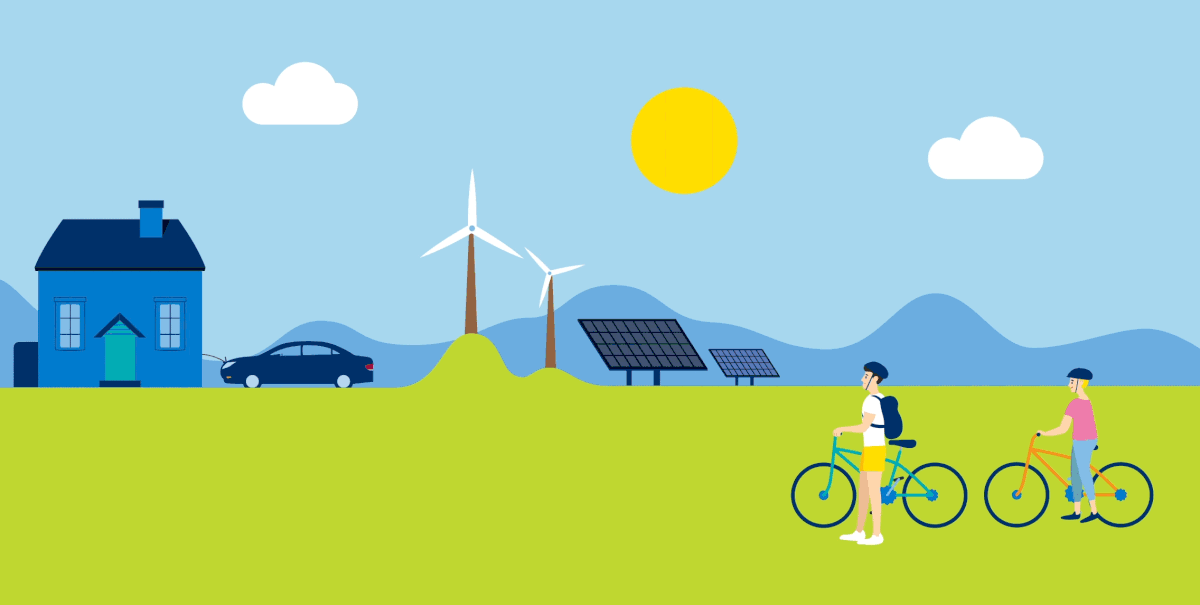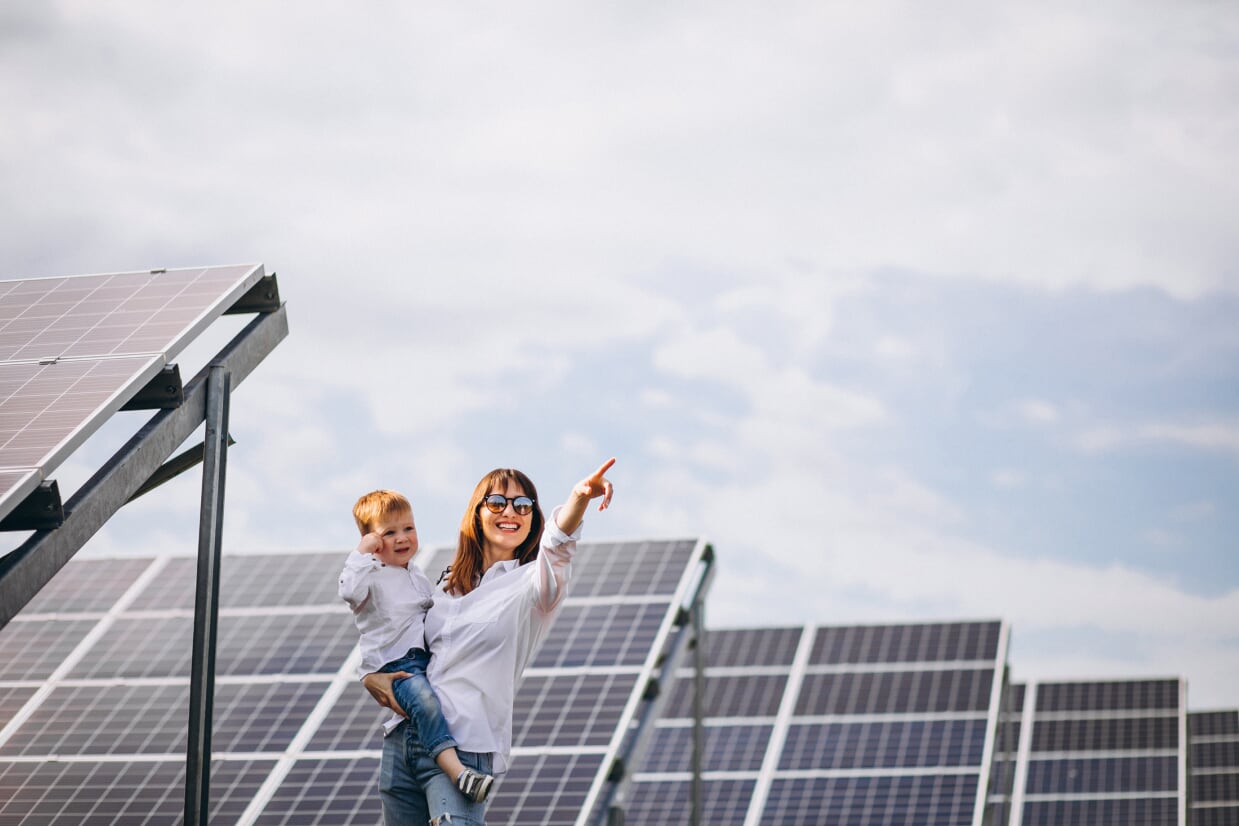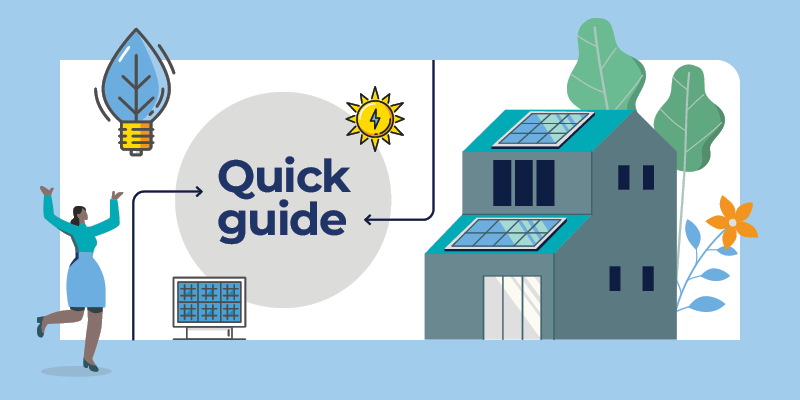Your guide to microgeneration in Ireland
Energy microgeneration for homes
Updated October 2025

What is microgeneration?
Microgeneration refers to the small-scale generation of electricity by households or small businesses to meet their own needs, in addition to their existing electricity supply. This is known as “self-consumption”.
The most common form of microgeneration and one you may be familiar with is solar panels, however, there are different types of microgeneration technologies available.
Types of microgeneration technologies
Microgeneration involves installing a small generator powered by a renewable source such as wind, solar or hydropower, and connecting this to the electricity network.
What is Solar PV?
Solar photovoltaic systems generate electricity during daylight hours only, predominately around the middle of the day. In Ireland, around 75% is produced from May to September. If this electricity is not used in the home it is exported to the grid.
A solar electric system (PV) is typically made up of:
- Rooftop solar panels, which generate DC (direct current – like in a battery)
- An ‘Inverter’ which converts this to AC (alternating current – like the electricity in your house socket)
- Sometimes a battery on larger systems that saves energy for later use
What is Micro-wind?
Micro-wind generation is a method of microgeneration that uses the flow of wind energy to produce renewable electricity for a house or farm. The wind turbines are much smaller in scale than those used in conventional wind generation, so they are suitable for domestic customers or small businesses.
What is Micro-hydro?
Micro-hydro generation requires a flow of water to generate renewable electricity. The flow of water is used to drive a turbine or pump which converts the flow to energy. An alternator is then used to transform this energy into electricity.
What is Micro-CHP Combined Heat and Power?
Micro combined Heat and Power is an efficient solution that captures the heat created through electricity generation, producing on-site heat and power at the same time. CHP systems are normally sized to meet heat demands, and used in sectors with a high heat demand, such as hotels or swimming pools.
Benefits of microgeneration
- On average, a solar PV system can save between €200-300 per year on your domestic energy bills.*
- If you sign up to an export tariff with us, you can earn money by selling surplus electricity you are not using to the grid. We'll pay you an export rate per kWh exported. See our FAQ on microgeneration for more details of the microgeneration payments and to see what you are eligible for.
*Source: SEAI (Sustainable Energy Authority of Ireland)
Microgeneration using renewable technologies reduces reliance on carbon energy sources and helps move towards a more sustainable future
You can now sign up for a microgeneration plan by signing into your online account. Sign in and choose to receive a payment for exporting your excess energy to the grid.
Sign inExport and earn with Bord Gáis Energy
Customers of Bord Gáis Energy are now entitled to a payment for any electricity exported to the national grid.
We are offering our customers, both business and homeowners, 18.5 cent per kWh for any excess electricity that they are microgenerating and exporting to the electricity grid under our Microgen Export Plan. This rate will be offered to both metered and eligible deemed* customers.
Microgeneration payments
- To receive a payment, you’ll need to agree to our Microgen Export Plan T&Cs
- If you were a Bord Gáis Energy customer on February 15th 2022 (date of legislation) and microgenerating at that time, your payment will be back-dated.
- If you joined us after February 15th 2022, payments will be back-dated to when you became an eligible customer.
- All payments will be based on the data provided to us by ESB Networks.
- Once you’ve exported for at least 3 months, payments will be made 4 times per year as a credit to your electricity bill. We started making our first payments from March 2023.
- If you’re eligible for a smart meter, you’ll need to have one installed to qualify for a payment.
* Deemed customers are customers who are not eligible under the National Smart Metering Program to have a smart meter installed. In this case, your export amount will be calculated (deemed) using a pre-determined formula.

Bord Gáis Energy are supporting our customers take-up of microgeneration technologies and move towards net zero.
Sign up for a microgeneration plan
You can now switch to a microgen plan by signing into your online account.
Sign in now and choose to receive a payment for exporting your surplus energy to the grid. Terms and conditions apply.

Who is eligible for the scheme?
- To qualify for an export payment with Bord Gáis Energy, you must have us as your energy supplier. Go to our plans page to see our available offers.
- You must have a microgenerator installed (i.e. solar PV, micro-wind, micro-hydro or renewable micro-CHP).
- You must have notified ESBN of your microgeneration connection to the grid (via an NC6 form or equivalent). If you are not sure whether your installer has completed this form, contact ESB Networks to confirm.
- If you're eligible to have a smart meter installed during this phase of the rollout, then you will need a smart meter to be paid for your export. Where customers are eligible to have a smart meter installed, ESB Networks will endeavour to install a smart meter within four months of a valid NC6 form being processed by ESB Networks.
- If you're not eligible to have a smart meter installed during this phase, then you'll be paid based on a deemed export calculation.
Download our Quick Guide for more information on eligibility for microgeneration export payments.

*MEC stands for Maximum Export Capacity. This refers to the capacity (measured in kW) of your microgeneration equipment.
** 24-hour meter customers (also known as MCC01 meter) are eligible for microgeneration payments if they have a smart meter. 3 phase MCC01 meters are not yet eligible for smart meters and qualify for deemed payments. Day/night meters(MCC02) are now included in the smart meter roll-out since September 2023. If your micro-generator installation was approved after 11 September 2023, you will need a smart meter to qualify for a microgeneration payment.
***'Deemed' relates to your Deemed Export Quantity. This is an estimation based on a formula, of your exported electricity in kWh. Your deemed export quantity is sent to us by ESB Networks in situations where metered export data is not available.
Find out more about how recent changes to smart meter eligibility affect microgeneration customers.
Learn more
For more information please visit our Help section or check out our most popular questions around microgeneration below.
- How do I sign up for the Microgen Export Plan?
- How do I qualify and apply for a microgen payment?
- What is deemed export quantity?
- How is my export payment calculated?
To learn more about how to get most out of your home electricity, visit our home electricity hub.
How to invest in microgeneration
✔ Get an assessment of the suitability of your property
✔ Apply for a grant from Sustainable Energy Authority of Ireland (SEAI)
✔ Install solar PV or other microgeneration technology
✔ Notify ESBN via an NC6 form (or equivalent)
✔ Secure an export tariff with Bord Gáis Energy. Eligible customers can sign in now and choose to receive a payment for exporting surplus energy to the grid.
Interested in starting a solar project?
Register your interest your interest with us to get a free solar survey.
Register your interestWhat is the Micro-Generation Support Scheme?
As part of its Climate Action Plan, the Irish government announced the launch of the Micro-Generation Support Scheme, which aims to incentivise homes, businesses, farms, and communities in Ireland to reduce their carbon footprint by using renewable generation technologies to produce their own clean energy.
A range of grants and supports were made available to boost Ireland's energy transition and encourage investment in micro-generators such as solar installations, micro-wind and micro-hydro power sources for renewable energy.
For further information on the grant scheme visit the SEAI's grant information hub. You can find more details on the government support scheme on gov.ie.
Recent changes to smart meter eligibility
What’s changing?
From September 2023, if you have any of the following meters, you’ll be eligible to receive a smart meter replacement:
- Day/night meters will be replaced with smart day/night meters. Day/night simply means you pay different unit rates for daytime (8am to 11pm) and night-time (11pm to 8am).
- 3 phase meters (24-hour only) will be replaced with smart 24-hour meters. 3 phase meters have 3 main fuses instead of one fuse in single-phase installations.
- Night storage heating customers who haven’t used their night storage heating register for over two years will be eligible for a smart meter exchange. Night storage customers pay a 24-hour unit rate for electricity, apart from any storage heating used overnight, which is charged at a lower rate. One thing to note is that for night storage heating, there’s a standing charge applied to both the 24-hour electricity and the night storage electricity. If you choose to switch to a smart meter, you’ll be on a 24-hour meter and will only pay one standing charge.
What does this mean for microgeneration customers?
If you’re receiving a deemed microgen payment, and are eligible for a smart meter installation, you must accept this to continue receiving your payments.
If you’ve objected to a smart meter installation in the past, you’ll need to remove this objection before the end of August 2023 to continue receiving your Microgen payments.
Why do I need to have a smart meter to continue to receive my payment?
Networks will no longer send us deemed export data for your microgeneration when you become eligible for a smart meter, so we will no longer be able to make your payment.
Why is deemed data no longer provided?
This is based on the CRU guidelines.
If you’re receiving a microgen payment, and are eligible for a smart meter installation, you must accept this to continue receiving your payment. If you’ve objected to a smart meter installation in the past, you’ll need to remove this objection before the end of August to continue receiving your microgen payments.
If you have not used your night storage heating register in more than two years, ESB Networks will offer you a smart 24-hour meter installation (MCC01). If you don’t object to this installation, the night storage heating meter will be removed and a 24-hour smart meter will be enabled.
If you’re currently receiving a Microgen payment, you’ll continue to receive this, regardless of whether a smart meter is installed.
Want to know more about smart meters?
Read our 'Ultimate Guide to Smart Meters' for a comprehensive look at this recent innovation, including information on the rollout in Ireland, the benefits of smart meters and how they work.
Smart Meter GuideYour journey to net zero
Embracing microgeneration is a significant step on Ireland’s path to a net-zero future. By generating your own renewable energy, you can lower your carbon footprint, reduce energy costs, and contribute to a cleaner, more sustainable environment for future generations.
Take advantage of the supports available, including grants and expert advice, to find the right solution for your home or business. Every step you take—whether installing solar panels or investing in wind or hydro solutions—brings you closer to energy independence and supports Ireland’s commitment to combat climate change.
For more information on all things solar and sustainable, visit our sustainability hub.
Frequently asked questions about microgeneration
Eligible customers can sign up through their online account, or by contacting us.
Under our Microgen Export Plan, Bord Gáis Energy currently offers our customers, both business and homeowners, 18.5 cent per kWh for any excess electricity that they’re microgenerating and exporting to the grid. This rate is subject to change.
This rate is offered to both metered and eligible deemed customers. Deemed customers are customers who are not eligible to have a smart meter installed. In this case, your export amount will be calculated (deemed) using a pre-determined formula. See here for more information.
You may qualify for a microgen payment from Bord Gáis Energy if:
- You're an existing Bord Gáis Energy electricity customer, or you're signing up for an electricity or Dual Fuel plan with Bord Gáis Energy.
- You're exporting electricity to the grid and have sent an NC6 or equivalent form to ESB Networks to connect your microgenerator to the grid. If you're unsure about this, we can check this as your supplier, or you can contact ESB Networks to confirm.
- If you're eligible for a smart meter, you must have one installed to qualify for a payment*. If you don't have a smart meter, see I don't have a smart meter, can I still get a payment for exporting electricity?
- You'll also need to accept our microgen export plan terms and conditions to receive a payment.
If you're eligible, you can sign up to our Microgen Export Plan via your online account by following the below steps:
1. Sign in to your online account. If you don't have an online account, register here.
2. Click on the grey banner below your account number 'You can sell your surplus energy' from your account list page:
Or from your account dashboard:
3. On the next page, click the 'Sign up' button:
4. Accept the terms and conditions and click 'Submit'. That's it, you're all set.
Payment will be made every six months as a credit to your supply invoice.
*If you're eligible to upgrade to a smart meter and object to a smart meter installation by ESB Networks, you'll be ineligible for payment for your exported electricity. For more information, visit cru.ie.
Deemed export quantity is used as a proxy for metered export data, where metered export data is not available.
The formula to calculate it is as follows: Deemed export quantity = MEC x Capacity Factor x Export Factor x Provision Interval.
Where:
- MEC is a capacity value in units of kW, representing the generation capacity of the installed generation equipment, as declared via ESBN’s NC6 (or equivalent) form.
- Capacity Factor is the ratio of average electricity produced to the theoretical maximum possible if the installed capacity was generating at a maximum for a full year. CRU have proposed this value is set at 9.7% for all technology types. It’s the average capacity factor of photovoltaic panels.
- Export Factor is the amount of electricity (expressed as a percentage of electricity produced) deemed to be exported, where the metered data is not available. CRU have set this value at 35%.
- Provision Interval is the number of hours in the period for which cumulative export quantities are to be calculated and to be made available to suppliers by ESBN.
Sample calculation for deemed export quantity:
Example 1: Residential customer with an MEC of 1.8 and where the "Provision Interval" is 12 months (= 8,760 hours)
ParameterParameter | ValueValue | CommentComment |
ParameterMEC (kW) | Value1.8 | CommentAs recorded by ESBN |
ParameterCapacity Factor | Value0.097 | Comment9.7% as decided by CRU |
ParameterExport Factor | Value0.35 | Comment35% as decided by CRU |
ParameterProvision interval | Value8760 | Comment12-month interval |
- Deemed export quantity = MEC x Capacity Factor x Export Factor x Provision Interval
- Deemed export quantity = 535.30kWh (=1.8 X 0.097 x 0.35 x 8,760)
We receive the deemed export quantity as calculated by ESB Networks and apply our microgeneration rate to this quantity.
If you've a smart meter, your export payment will be calculated based on metered export data which is sent from your meter to ESB Networks.
ESB Networks will share this data with us as your current electricity supplier. This volume will be multiplied by our export rate to calculate your payment.
There may be some instances where ESB Networks is unable to provide your supplier with metered export data for a period. If metered export data is unavailable, ESB Networks will provide your supplier with deemed export data for that period, and this will be used to calculate your export payment.
This may result in some differences between the amount of export shown on the meter, and the volume used for payment.
If your meter is not eligible to be exchanged for a smart meter, your export payment will be calculated using a deemed export quantity.
Maximum export capacity (MEC) is the capacity value in units of kW, representing the maximum generation capacity of the installed microgeneration equipment, as declared via ESBN’s NC6 (or equivalent) form.
We receive a notification of your MEC from ESB Networks when your installation has been approved. This date will be the effective date of your MEC. If your MEC is incorrect, or you've a question about your MEC, please contact ESB Networks directly.
If your solar panels produce more electricity than you need, you can sell it back to the grid by signing up to Microgeneration via your online account.
Sustainability hub
Sustainable energy is no fad - it's very much the future. So embrace it with our expert advice and services.
Smart meter guide
Your smart meter gives you the power to see exactly how much energy you're using, in near real-time. Learn more in our ultimate guide.
Beginner's guide to solar
Find out all you need to know about solar energy with our comprehensive beginner's guide.